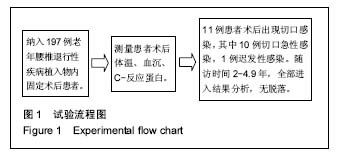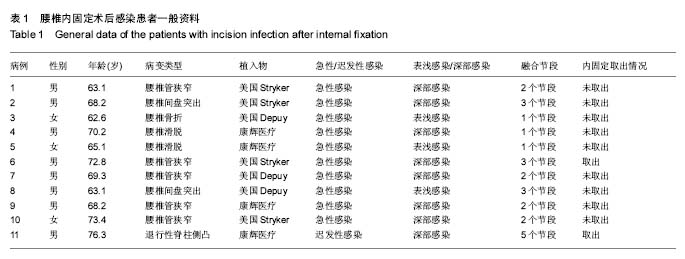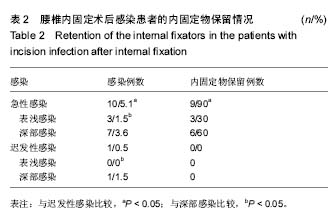| [1] Gopinathan P. Lumbar spinal canal stenosis-special features. J Orthop. 2015;12(3):123-125. [2] 史建刚,贾连顺,袁文,等.腰骶神经损害致马尾神经综合征的临床分期及早期诊断[J]. 中国矫形外科杂志,2005,13(7):491-493.[3] 赵慧毅,梅芳瑞,叶欣,等.腰椎管狭窄症的手术减压与内固定选择(259例临床分析)[J].中国脊柱脊髓杂志,2003,13(1):18-21.[4] 刘玉军,李学民,朱瑜琪. 闭式抗生素灌洗治疗腰椎间盘术后椎间隙感染的效果[J]. 中国矫形外科杂志,2007,15(7):554-556.[5] Mok JM, Pekmezci M, Piper SL, et al. Use of C-reactive protein after spinal surgery. Spine. 2008;33:415-421.[6] Hong HS, Chang MC, Liu CL, et al. Is aggressive surgery necessary for acute postoperative deep spinal wound infection? Spine. 2008;33: 2473-2478.[7] Kim JI, Suh KT, Kim SJ, et al. Implant removal for the management of infection after instrumented spinal fusion. J Spinal Disord Tech. 2010;23: 258-265.[8] Rayes M, Colen CB, Bahqat DA, et al. Safety of instrumentation in patients with spinal infection. J Neurosurg Spine. 2010;12: 647-659.[9] Sierra-Hoffman M, Jinadatha C, Carpenter JL, et al. MD-Postoperative Instrumented Spine Infections:A Retrospective Review. South Med J. 2010;1(103):25-30.[10] Turnbull F. Postoperative in?ammatory disease of lumbar discs.J Neurosurg,1953,10:469-473.[11] Rihn JA, Lee JY, Ward WT. Infection after the surgical treatment of adolescent idiopathic scoliosis: evaluation of the diagnosis, treatment, and impact on clinical outcomes. Spine. 2008;33: 289-294. [12] Kanafani ZA, Dakdouki GK, El-Dbouni O, et al. Surgical site infections following spinal surgery at a tertiary care center in Lebanon: incidence, microbiology, and risk factors. Scand J Infect Dis. 2006;38: 589-592. [13] 刘少强,齐强,刘宁,等.脊柱术后耐甲氧西林金黄色葡萄球菌感染的治疗-附8例报告[J]. 中国脊柱脊髓杂志,2014,24(2):164-167.[14] Sasso RC, Garrido BJ. Postoperative spinal wound infections. J Am Acad Orthop Surg. 2008;16:330-337.[15] An HS, Seldomridge JA. Spinal infections: diagnostic tests and imaging studies. Clin Orthop Relat Res. 2006;444:27-33.[16] Pull ter Gunne AF, Mohamed AS, Skolasky RL,et al. The presentation, incidence, etiology, and treatmentof surgical site infections after spinal surgery. Spine. 2010;35:1323-1328.[17] Enoch DA,Cargill JS, Laing R.Value of CT-guided biopsy in the diagnosis of septic discitis. J Clin Pathol. 2008;6:750–753.[18] Chaudhary SB, Vives MJ, Basra SK. Postoperative spinal wound infections and postprocedural discitis. J Spinal Cord Med. 2007;30:441-451.[19] Mok JM, Guillaume TJ, Talu U, et al. Clinical outcome of deep wound infection after instrumented posterior spinal fusion: a matched cohort analysis. Spine. 2009;34:578-583.[20] Collins I, Wilson-MacDonald J, Chami G, et al. The diagnosis and management of infection following instrumented spinal fusion. Eur Spine J. 2008;17:445-450.[21] Mehbod AA, Ogilvie JW, Pinto MR,et al. Postoperative deep infections in adults after spinal fusion: management with vacuum-assisted wound closure.J Spinal Disord Tech. 2005; 18:14-17.[22] Akins PT, Harris J, Alvarez JL, et al. Risk factors associated with 30-day readmissions after instrumented spine surgery in 14,939 patients. Spine (PhilaPa 1976). 2015;40:1022-1032.[23] Bydon M, Macki M, De la Garza-Ramos R, et al. Smoking as an independent predictor of reoperation after lumbar laminectomy: a study of 500 cases. J Neurosurg Spine. 2015;22:288-293.[24] Lim S, Edelstein AI, Patel AA, et al. Risk factors for postoperative infections following single level lumbar fusion surgery. Spine (Phila Pa 1976). 2014;40:1022-1032.[25] Chahoud J, Kanafani Z, Kanj SS. Surgical site infections following spine surgery: eliminating the controversies in the diagnosis. Front Med(Lausanne). 2014;1:7.[26] Chiang HY, Herwaldt LA, Blevins AE, et al. Effectiveness of local vancomycin powder to decrease surgical site infections: a meta-analysis. Spine J. 2014;14:397-407.[27] Srinivasan D, La Marca F, Than KD, et al. Perioperative characteristics and complications in obese patients undergoing anterior cervical fusion surgery. J Clin Neurosci. 2014;21:1159-1162.[28] Tetreault L, Nouri A, Singh A, et al. An assessment of the key predictors of perioperative complications in patients with cervical spondylotic myelopathy undergoing surgical treatment: results from a survey of 916 AO Spine International Members. World Neurosurg. 2015;83:679-690.[29] Liu X, Wang Y, Qiu G, et al. A systematic review with meta-analysis of posterior interbody fusion versus posterolateral fusion in lumbar spondylolisthesis. Eur Spine J. 2014;23:43-56.[30] Maruo K, Berven SH. Outcome and treatment of postoperative spine surgical site infections: predictors of treatment success and failure. J Orthop Sci. 2014;19: 398-404.[31] Calvert G, May LA, Theiss S. Use of permanently placed metal expandable cages for vertebral body reconstruction in the surgical treatment of spondylodiscitis. Orthopedics. 2014;37:e536-542.[32] Eder C, Schenk S, Trifinopoulos J, et al. Does intrawound application of vancomycin influence bone healing in spinal surgery? Eur Spine J. 2016;25(4):1021-1028.[33] Zebala LP, Chuntarapas T, Kelly MP, et al. Intrawound vancomycin powder eradicates surgical wound contamination: an in vivo rabbit study. J Bone Joint Surg. 2014;96:46-51. [34] Chiang HY, Herwaldt LA, Blevins AE, et al. Effectiveness of local vancomycin powder to decrease surgical site infections: a meta-analysis. Spine J. 2014;14(3):397-407. [35] Tomov M, Mitsunaga L, Durbin-Johnson B, et al. Reducing surgical site infection in spinal surgery with betadine irrigation and intrawound vancomycin powder. Spine. 2015;40:491-499. [36] Ghobrial GM, Thakkar V, Andrews E, et al. Intraoperative vancomycin use in spinal surgery: single institution experience and microbial trends. Spine. 2014;39:550-555. [37] Bakhsheshian J, Dahdaleh NS, Lam SK, et al. The use of vancomycin powder in modern spine surgery: systematic review and meta-analysis of the clinical evidence. World Neurosurgery. 2015;83:816-823. [38] Hill BW, Emohare O, Song B, et al. The use of vancomycin powder reduces surgical reoperation in posterior instrumented and noninstrumented spinal surgery. Acta neurochirurgica. 2014;156:749-754. [39] Theologis AA, Demirkiran G, Callahan M, et al. Local intrawound vancomycin powder decreases the risk of surgical site infections in complex adult deformity reconstruction: a cost analysis. Spine. 2014;39:1875-1880. [40] Martin JR, Adogwa O, Brown CR, et al. Experience with intrawound vancomycin powder for spinal deformity surgery. Spine. 2014;39:177-184. [41] Armaghani SJ, Menge TJ, Lovejoy SA, et al. Safety of topical vancomycin for pediatric spinal deformity: nontoxic serum levels with supratherapeutic drain levels. Spine. 2014,39: 1683-1687. |
.jpg) 文题释义:
文题释义:


.jpg) 文题释义:
文题释义: